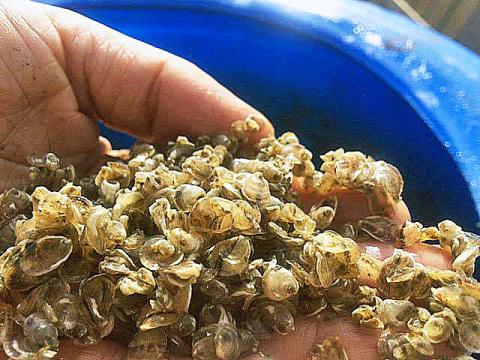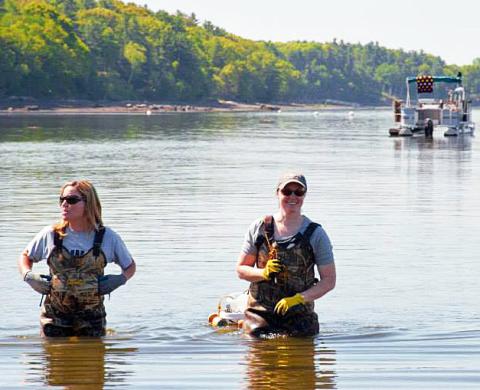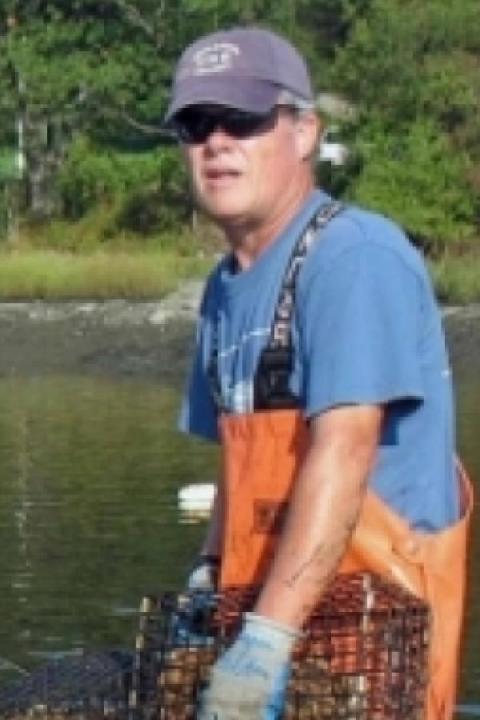About the Research
Delicious eastern oysters (Crassostrea virginica) are a favorite food of New Englanders. In New Hampshire, they are commercially produced on farms and can be recreationally harvested from wild reefs in the Great Bay Piscataqua River estuary. Ray Grizzle, a research professor with UNH’s biological sciences department and a researcher with the New Hampshire Agricultural Experiment Station, and his colleagues in the Grizzle Laboratory research best practices for cultivating oysters and quantifying the ecological roles played by both wild and aqua-cultured oyster populations. This is referred to as the ecosystem approach to aquaculture.
For about 20 years, Grizzle and his team have studied oyster growth and mortality under different cultivation and restoration conditions in Great Bay. They have quantified relationships between the density of oysters in racks and their growth rates and discovered that the gear used to hold the oysters on farms also adds habitat for seaweeds – just like restoring wild oyster reefs enhances the ecosystem services that oysters provide.
Aquaculture researchers with the Grizzle Lab have also found that oysters are an excellent vehicle for the bioextraction of nutrients from Great Bay estuary. One of the most concerning of nutrients is nitrogen, which is delivered to the Bay via rivers that receive treated wastewater from more than a dozen wastewater treatment plants located in the Piscataqua Region Watershed. The nitrogen in the water is taken up by phytoplankton, just like when fertilizer is added to a lawn to encourage grass growth. However, too much nitrogen in the Bay causes too much phytoplankton to grow, resulting in eutrophication (or excessive nutrient richness), which in turn can decimate native plant and animal life. Fortunately, phytoplankton is a favorite food of oysters.

Why the Research is Important
- Eastern oyster farm production has increased dramatically in the Northeastern United States in the past few decades. Farmed oysters are now being incorporated into reef restoration programs.
- The gear used to hold aquacultured oysters during the 2-to-4 year cultivation period is expensive, and researchers with the Grizzle Lab have learned that placement in the water column of oyster bags in “racks” has important implications on the rate of speed of oyster growth.
- When oysters are harvested, their removal from the estuary represents a removal of nutrients from the ecosystem – nutrients that otherwise might contribute to eutrophication.
- Valuation of ecosystem services is difficult to accurately assess because there are many factors involved, many of which cannot be controlled. How would a manager or banker determine whether an oyster farmer should earn a credit for helping to remove nutrients that were delivered to Great Bay via point or nonpoint pollution sources? Researchers with the Grizzle Lab can measure the quantity of nitrogen harvested when oysters are removed and also the quantity of nitrogen sequestered and processed when oyster reefs are restored. Furthermore, as restored reefs grow and add oysters, the oysters in these reefs assimilate nitrogen and carbon into their tissues and shells.

Interesting Findings
- There is a higher percentage of nitrogen found in petite oysters (shell size of 2.5-3 inches) than is found in regular-sized oysters (3-5 inches) and jumbo-sized oysters (larger than 5 inches). So harvesting the smaller oysters results in a faster bioextraction of nutrients.
- Petite oysters = 8.3 percent nitrogen
- Regular-sized oysters = 7.9 percent nitrogen
- Jumbo oysters = 5.6 percent nitrogen
- Careful attention to stocking density of farmed New Hampshire oysters has the potential to decrease the average time to market from 3-4 years to under 2 years.
Big Picture

By filtering and consuming phytoplankton, oysters sequester nitrogen and other elements in their meat and shell. At the present rate of production and harvest in Great Bay, oysters are removing just under 1 percent of the nitrogen delivered to the Bay. However, combining the aquaculture and reef restoration efforts will result in an even higher rate of naturally removed nitrogen from Great Bay. Bioextraction is one of many tools in the nutrient management toolbox that can be wielded by townships, management agencies, and the Piscataqua Region Estuaries Partnership (PREP) to prevent eutrophication in the Great Bay Piscataqua River estuary.
In addition to bioextraction, there are also molecular transformations of nitrogen that occur on reefs (one of which is “denitrification,” which turns bioavailable nitrogen into nitrogen gas). Aquaculture researchers with the Grizzle Lab have found that the current amount of aquacultured oysters can potentially remove more nitrogen through bioextraction than restored reefs can sequester and promote through denitrification. This type of research can help put a distinct value on the ecosystem services delivered through oyster bioextraction in the Great Bay Piscataqua River estuary.
Funding
- New Hampshire Agricultural Experiment Station
- New Hampshire Sea Grant
- National Oceanic and Atmospheric Administration
Related Published Works
- Bricker SB, et al. 2020. Bioextractive removal of nitrogen by oysters in Great Bay Piscataqua River Estuary, New Hampshire, USA. Estuaries and Coasts. 43:23-38.
- Grizzle RE, et al. 2016. Growth, morphometrics and nutrient content of farmed eastern oysters, Crassostrea virginica (Gmelin), in New Hampshire, USA. Aquaculture Research. 2016:1-13.
- Glenn M, et al. 2020. Seaweed communities in four subtidal habitats within the Great Bay estuary, New Hampshire: Oyster farm gear, oyster reef, eelgrass bed, and mudflat. Journal of Experimental Marine Biology and Ecology. 524:151307
- Grizzle R, et al. 2020. Eastern Oyster Crassostrea virginica Growth and Mortality in New Hampshire (USA) Using Off-Bottom Farm Gear. North American Journal of Aquaculture. 82:132–142.
Additional Resources
UNH Today articles:

Raymond Grizzle
Research Professor of Biological Sciences
Ray.Grizzle@unh.edu; 603-862-5130

This project recieved funding support from the New Hampshire Agricultural Experiment Station at UNH!